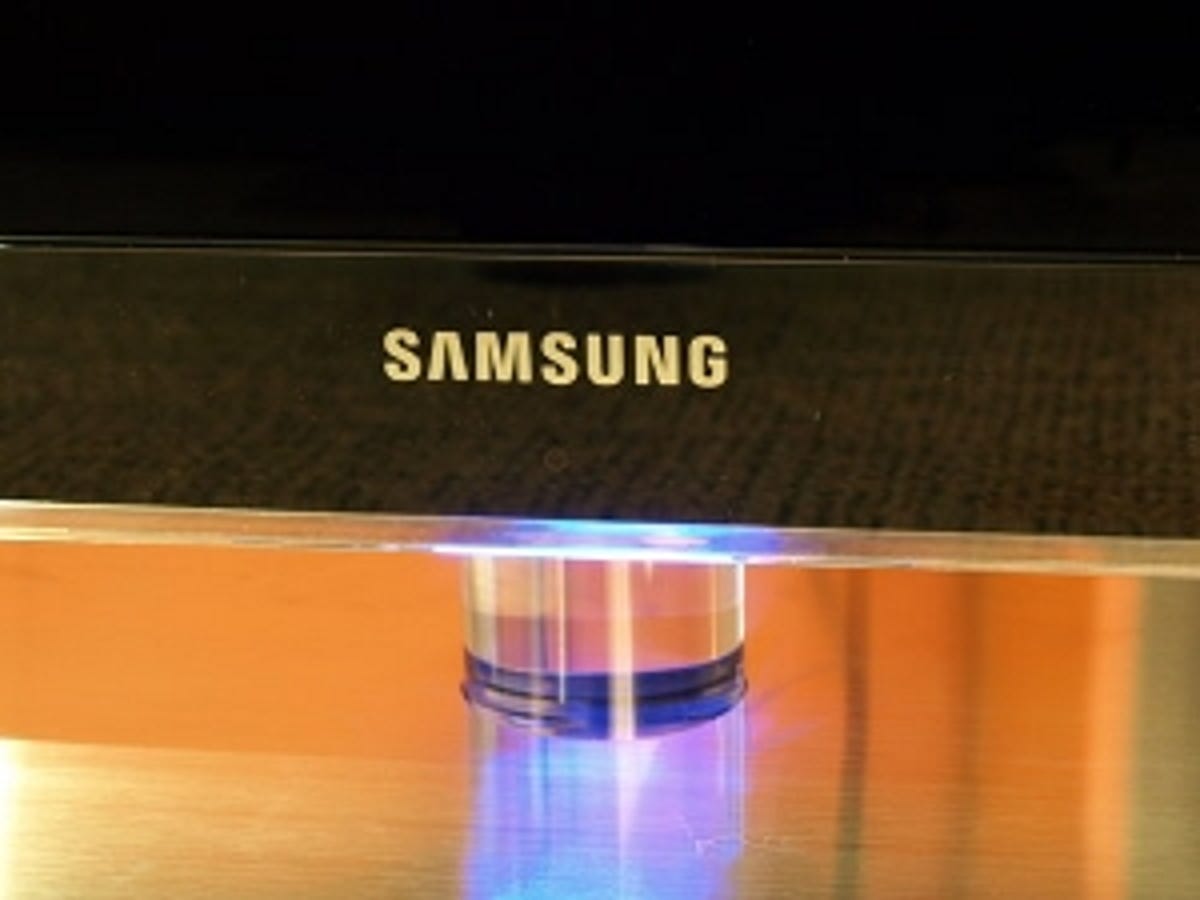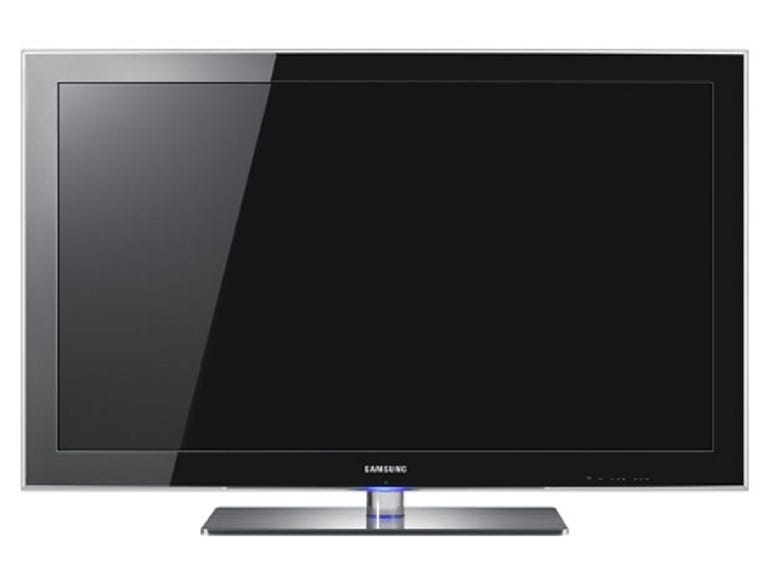 Why You Can Trust CNET
Why You Can Trust CNET Samsung UE46B8000 review: Samsung UE46B8000
The 46-inch, 1080p, LED-edge-lit UE46B8000 is fantastically thin, offers excellent picture quality and is packed full of useful and entertaining features. It's pricey and there are some patchiness issues with the backlight on rare occasions, but this is a remarkable set
The Samsung UE46B8000 is a 46-inch, 1080p LCD TV with LED edge lights and a host of superb extra features. At around £1,800, though, it's not an especially cheap TV. The question is: is this set worth the money?
The Good
The Bad
The Bottom Line
LED edge lighting
With LCD TVs, there are two different backlight technologies in use. The first, and by far the most common, is known as cold cathode fluorescent lamp (CCFL) backlighting. CCFL backlighting technology essentially comprises of a series of fluorescent tubes that run behind the LCD panel itself. This is a popular system because it's inexpensive, tried and tested, and has a long life span.
The second and newer method of backlighting uses LEDs to illuminate the LCD panel. These LEDs are placed behind the panel and can be dimmed selectively to increase the contrast ratio of the TV. The problem is, loads of LEDs are needed and TVs using this technology generally cost a bomb.
Now, however, a sort of compromise has arrived. Known as LED edge lighting, it works in exactly the way you'd think from the name. Around the edge of the TV are LEDs. Their light is diffused across the back of the panel, using a clever, proprietary system. This method works very well indeed, and it's an interesting technology to watch in the years ahead while we wait for OLED to arrive.
Styling
Because LED edge lighting is a more compact method of illuminating an LCD screen, it enables manufacturers to slim down their screens to the point where they have a profile of virtually nothing. There are pictures in the National Gallery that have deeper frames than the UE46B8000, and that makes it ideal for wall mounting.

Of course, nothing in this world is free -- the wall mount for this TV is a fairly expensive optional extra, but it's designed to wow everyone who sees it. You'll have to decide if that's important to you. We really like the supplied table-top stand, and don't see any real reason to bother wall mounting this delightful-looking TV.
Connectivity
Because of the TV's diminutive proportions, there isn't room on the back for every kind of socket known to humanity. To overcome this, Samsung has used an arrangement of breakout cables to make a Scart connector fit into the space taken by a 3.5mm headphone jack. It's all very clever, but it gives us some minor quality concerns. It's also much more untidy that most other TV systems, which might be an issue for people who want to mount this set on the wall. That said, we prefer everything to be built into the TV, rather than having to use a media box to get our video in.
You do get full-sized sockets for HDMI and VGA though, which means Blu-ray players, games consoles and computers can all be accommodated without any problem. The inclusion of four HDMI inputs seems generous enough, and, with switcher boxes costing a minimal amount these days, if you do run out of sockets, it's not the end of the world. There's also an optical digital output too, for connecting the TV to your home-cinema system.
A pair of USB sockets is included as well. Samsung expects that most people will want to use one for a Wi-Fi dongle and the other for a USB hard drive or memory stick. The TV can easily cope with video, images and music in this way, and the whole system works very well indeed.
Media support
As with Samsung's B7000 range, the UE46B8000 can play a variety of video formats. MPEG-4, MPEG-2 and MPEG-1 are all catered for. You can also play back DivX and Xvid files, and MKV container support is included too. We played back 1080p video with no problem, but we should point out that audio codec support is rather lacking. For example, the UE46B8000 can't decode DTS audio, and Dolby TrueHD and DTS-HD MA are out of the question.
While this TV has truly brilliant video playback, it's not perfect. But it's still much better than any other TV we've used, and the media features are so beautifully integrated that it's a pleasure to use. As you would imagine, photos and music are both catered for too. We listened to MP3s and looked at JPEG photo slideshows with no trouble, and thoroughly enjoyed ourselves.
Freeview picture quality
One of the biggest surprises with the UE46B8000 is its charming Freeview picture. This TV handled our lunchtime viewing -- Neighbours and Home and Away on Five, with a smattering of The Jeremy Kyle Show over on ITV2 -- with significant poise.
The Australian soap operas are both produced in high definition, and generally look pretty good on Freeview. The UE46B8000 certainly does a magnificent job of presenting a crisp, clean image with plenty of detail. The Jeremy Kyle Show, with its bright blue set and vivid fake tans looked impressive. ITV2 isn't known for its high bit rate, so for the TV to cope with this channel is an impressive feat.
The only problem we had with this TV was when we switched over to Virgin 1 for an episode of Star Trek: Voyager. We noticed that, because this show is often quite dimly lit, the backlight would appear to pulse slightly, as it struggled to set its brightness level to suit the material. This is very distracting and distinctly undesirable. We didn't, however, have any real problem with it on other material, so we're not going to suggest that this is a huge issue.
HD picture quality
Blu-ray movies on this TV look simply stunning. The true skill of this set really becomes apparent with the opening scenes of Casino Royale, when the initial grainy black and white scene swiftly becomes a bright, animated title sequence. The UE46B8000 handles both brilliantly.
With this film, the detail on faces, scenery and clothes is superb, on-screen text looks as sharp as a pin, and, during the title sequence, the colour and crispness of the animation is truly jaw-dropping. With the colour scenes, the TV manages to portray a realism and life-like quality that we find utterly wonderful.
Audio ability
The built-in speakers are Samsung's usual downward-firing, hidden affairs. It's not a bad system for normal TV viewing, but watching action films or anything that requires more than one sort of sound to be produced at once is unlikely to sound great. If you're spending this much on a TV, you'd be wise to pony up for some external speakers and an AV receiver to complement it.
Hertz arms race
It seems to be almost required now that manufacturers rush to make the TV with the most hertz possible. This year's magic number is 200. Please, we urge you, do not be fooled by this idiotic bluster and blatant nonsense.
200Hz and even 100Hz picture modes simply cannot create information that isn't there. With the UE46B8000, turning on the 200Hz mode with a Blu-ray playing turns the on-screen picture into something that, for the most part, is much smoother than film, but to such an artificial degree that it's painful to watch.
The real problem, however, is the abysmal artefacting that this mode introduces. It's very hard to describe how it destroys the picture, but, when engaged, the 200Hz mode creates blocks of distortion around fast-moving objects. It's a picture-quality travesty, and we object to it on every possible level. If you really hate the film look that's inevitable with, erm, films, then you can use the 'clear' mode, but it's very subtle, and won't give you that pseudo-video look of the higher settings.
Unusual remote
The remote supplied with the UE46B8000 is rather different to other TV controllers. Instead of relying on infrared to control your TV, it uses radio frequencies. The advantage of using radio frequencies to change channel or turn the volume up is that you don't need to have the remote pointed at the TV to do it. In fact, as long as you're in RF range of the TV, you can be in a different room and still control the TV. That's handy for some people, but it's a pain if you use a universal remote control that doesn't have RF capabilities.
The remote is also backlit, with an appealing twist. At the top of the controller is a light sensor that prevents the remote lighting up when there is sufficient ambient light for you to see the buttons. The remote also has a built-in motion sensor, so just picking the controller up will illuminate the controls if necessary. This is terrifically useful if you're watching a movie in the dark, and we'd like to see this feature on more remotes.
Widgets
Older readers will remember the John Smith's bitter adverts from the '90s, which claimed a mysterious 'widget' was placed into the can to give your bitter a 'draught-poured' look and smoothness. The UE46B8000's widgets won't help your movie-night pint, but they will allow you to connect to the Internet and get news, weather and sports results delivered to your screen.
Samsung has also introduced a Twitter app recently, which enables users of the microblogging site to check their updates while they settle in to watch an episode of Big Brother. We're really taken with the Samsung widget engine -- it's aesthetically beautiful and potentially really useful.
Our only concern is that the TV's processing power seems insufficient to properly handle the apps. Loading the system is slow, and navigating around the apps can be a real pain. As good as the Twitter app is for looking at received messages, sending from the TV is a no-no. The interface is just too slow and clunky, and one short message took us more than 10 minutes to enter. We also made a couple of mistakes because it's so hard to use.
Conclusion
We like the Samsung UE46B8000 a great deal. Its picture is almost ludicrously sharp and detailed at times, and, even with Freeview, it can blow your socks off with its fantastic detail and colour. The UE46B8000's styling is nearly perfect, Samsung couldn't have fitted in more useful and enjoyable features if it tried, and, overall, we think it's a terrific piece of kit.
Of course, plasma TVs do away with all backlight issues, and, if you're a movie fan, we'd urge you to consider a Panasonic or Samsung plasma. Also, if you can track one down, the excellent Pioneer Kuro PDP-LX5090 plasma TV is about the same price.
Edited by Charles Kloet
